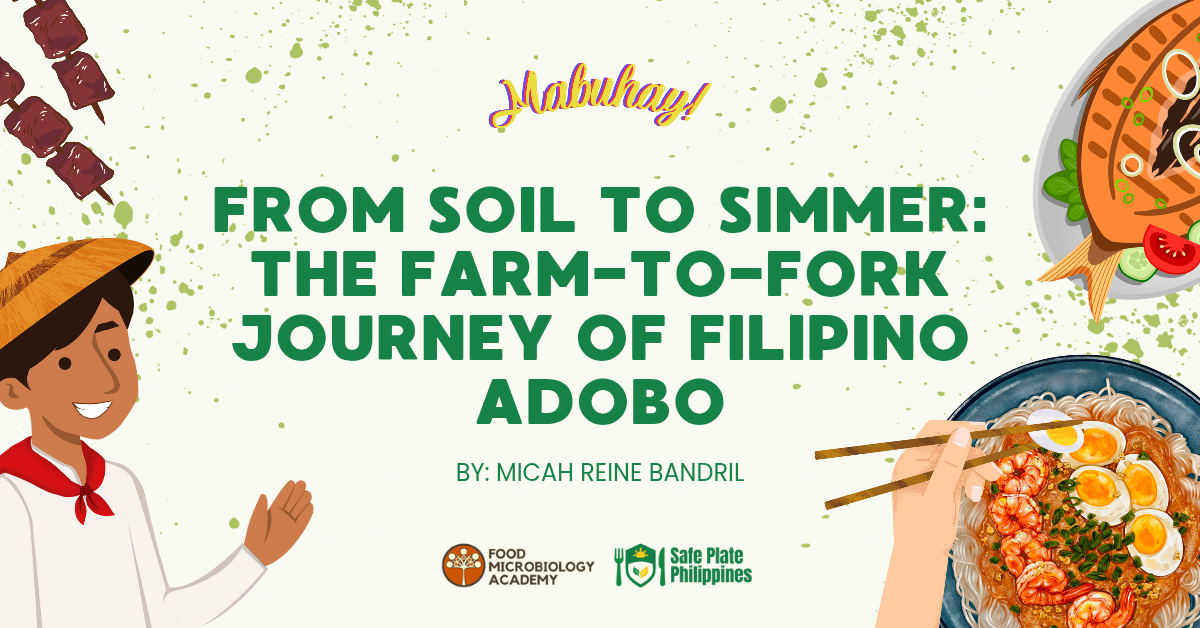This blog is written by Micah Reine Bandril under the theme “From Farm to Fork” and as part of the #SafePlatePH digital advocacy campaign promoting practical, science-based food safety for Filipino homes.
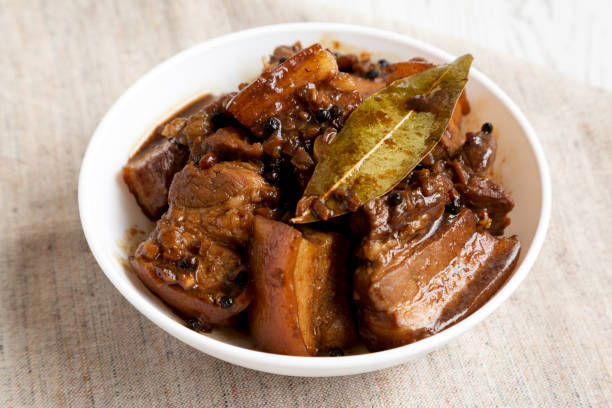
Photo from: Getty Images
Close your eyes for a second. Can you smell it?
That pungent combination of soy sauce, vinegar, and garlic that goes through the air, the aroma that makes any house a home. It’s the smell that brings overseas Filipino workers to tears of homesickness, the fragrance that draws children to the kitchen like moths to a flame, the scent that guarantees “everything will be alright” after the longest day.
Adobo is our Philippine national dish, but more than that, it’s our food biography in brown sauce and soft meat. It’s the recipe that withstood centuries of colonization, the food that transcends generations, the dish that makes us uniquely, unapologetically Filipino.
But here’s a question for you: when did you ever sit down and consider where your adobo actually comes from? Not the recipe from your family, but the ingredients themselves—the pork that becomes tender in that deep sauce, the onion and garlic that perfumes your kitchen, the rice that soaks up every last drop of its sabaw.
We mostly encounter adobo as it comes onto our plates, intact and ready to be consumed. But behind every mouthful are a series of farmers, traders, processors, and distributors whose narratives never get discussed in our evening conversation. Today we delve deeper into the process that every ingredient goes through from earth to boil to learn about the agricultural and economic systems that get our favorite adobo to us.
Pork: The Star of the Dish
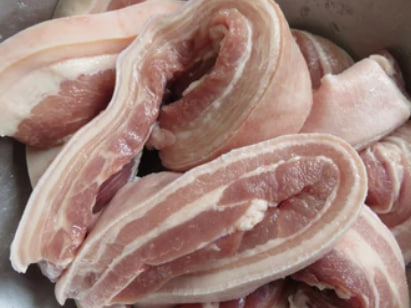
Photo from: Shutterstock
We begin with the show-stopper: adobo-kissed pork that is tenderized. The path of this protein starts in the rural areas of the country, where until March 2024, most of the Philippines’ pig population belong to smallhold farms (70.4%), commercial farms (27.1%), and semi-commercial farms (2.4%) (Sy, 2024).
Imagine a common rural Nueva Ecija or Batangas backyard farm: a small-scale operation where 5-10 pigs dig around in simple enclosures, being fed on kitchen waste, rice bran, and vegetables grown on the farm. These are small-scale family businesses where there is a name for every pig, where old-fashioned farming skills that have been passed on from generation to generation converge with the practicalities of eking out a living from the land.
Commercial hog farms, however, maintain over 20 mature hogs or over 10 mature hogs with at least 22 weaner hogs or over 40 weaner hogs. In contrast with backyard hog farms, commercial hog farms are typically backward integrated and manufacture their own feeds for production (DOST-PCAARRD, 2021). These establishments are often the industrialization of pork production, with complete automated feeding systems, climate control, and veterinary regimens that guarantee uniform meat quality and food safety standards.
It’s a complicated logistics from the farm to your neighborhood markets. The pork needs to be stored in a cold chain and refrigerated or frozen while in transit after slaughtering to be fresh and safe. It sounds easy, but in practice, there are meat trucks driving on rough rural roads, periodic power outages at processing plants, and the challenge of keeping stable temperatures in a tropical environment.
Recent years also spurred another challenge with the outbreak of African Swine Fever (ASF) that wiped out pig inventories across the country. From 2019 to 2022, backyard farm and commercial farm swine inventories declined by 8.2% and 21.8% respectively (Sy, 2024). This crisis showed us just how integrated our food chains are, just as when pigs in Luzon are sick, Mindanao families would feel the pinch in their grocery bills. It is estimated that the 2025 pork production will reach 1.06 million metric tons carcass weight equivalent, showing a modest recovery from 2024 estimates as the ASF crisis abates (Gaz & Ward, 2024).
However, the challenge of sustainability weighs heavily over pig farming. While small farms are more organic and traditional, it finds it difficult to scale up to match rising demand. Commercial farms, on the other hand, can produce more meat more cheaply but at the expense of animal welfare, antibiotic resistance, and environmental degradation (Fernandez-Colorado et al., 2024). It’s a conflict that is echoed by broader arguments over how we balance tradition and modernity, small-scale sustainability and large-scale efficiency.
Garlic and Onion: The Aromatic Anchors
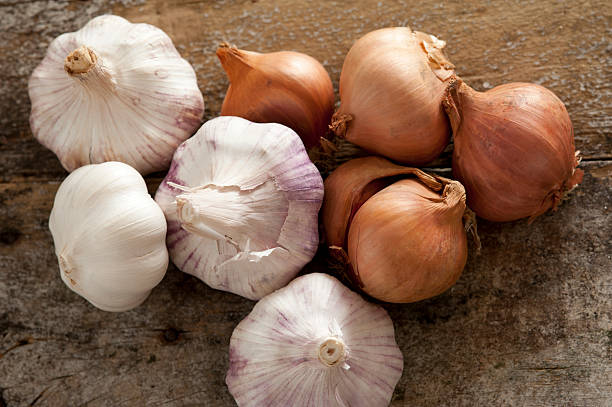
Photo from: iStock
No adobo starts without the sacred process of sautéing garlic and onion, but the tale of their origins is a rich one of local pride against the global economy.
Philippine garlic, specifically from Ilocos Region and Batanes, has been considered legendary. With 2022 production, the Ilocos Region alone had 4,502.58 metric tons of garlic (Philippine Statistics Authority, 2023). The garlic that grows locally is smaller than the imported variety, but they compensate with a stronger taste. The indigenous bulbs are “mas malasa at mas mabango“, which means they are more aromatic and flavorful with an intensity of pungency that brings tears to your eyes and a smile to your palate (Micua, 2017).
But here’s the unfortunate reality: the Philippines is currently only at around 20% self-sufficiency in garlic, and roughly 80% of garlic eaten is imported, with the Department of Agriculture attempting to increase this to 20% by increasing local production (Arcalas, 2024; Fresh Plaza, 2024). In short: imported garlic is cheaper and more convenient than local garlic (Andrade, 2022). For the majority of Filipino families operating on tight budgets, choosing between authentic local flavor and lower-priced imported versions isn’t really a choice at all.
The garlic that ends up in your hometown market has taken one of two relatively distinct journeys. Local garlic takes the traditional path: hand-picked, sun-dried, tied into bundles for shipping, and sold through networks of local merchants who’ve developed relationships over several decades. Every process has human touch and old wisdom, from farmers who understand precisely when bulbs are ready to harvest to market merchants who can advise you which kind will have the best taste.
Imported garlic, however, falls under industrial supply chains. That is to say, gigantic shipping containers, bulk distributors, and retail systems optimized for volume and efficiency and not face-to-face relationships. It’s commodity garlic instead of craft, useful in the sense that it makes food accessible but unconnected to tradition that makes local types unique.
Onions have a similar journey, but with seasonal variation that can make a tremendous difference in your adobo cost. Onion cultivation in the Philippines is largely in Nueva Ecija, Ilocos Norte, and Occidental Mindoro, and most of it is harvested between January and May (Garcia, 2024). At the peak season, onions are everywhere and cheap. Hold on until out-of-season, though, and your neighborhood market is offering onions that cost higher per kilo than some types of meat. This natural seasonal fluctuation has been further compounded by supply chain mismanagement and hoarding, practices that turn a natural cycle of agriculture into an economic crisis for ordinary families.
Soy Sauce, Vinegar, Spices: The Tangy Trio

Photo from: Nicole Coudal
While the pork, garlic, and onion take center stage, the real essence of adobo is in the liquid ingredients: the soy sauce and vinegar that turn mere ingredients into near-heavenly dishes. These condiments are among the most industrialized parts of our adobo‘s manufacture, but they are created by firms that have become part of Filipino existence.
Step into any Filipino kitchen, and you’ll likely see bottles of Datu Puti, Silver Swan, or Marca Piña, names that have managed the rare accomplishment of becoming household names on economic and geographical levels. The manufacture of soy sauce and vinegar are industrial processes that appear as far from the farm-to-fork narrative as possible, but are as closely linked to agricultural systems. Soy sauce manufacture starts with soybeans, usually imported, which are fermented with wheat and salt through processes that span months (MasterClass, 2021). Vinegar, on the other hand, is usually made from sugarcane molasses or coconut sap, linking it to the Philippines’ huge sugar and coconut industries (Antonio, 2023).
The peppercorns and bay leaves that give adobo its depth and complexity are the most globalized of the ingredients in the dish. These tend to be the spices that travel the farthest, coming in through webs of spice dealers and dry goods importers who obtain them from all over the world on the basis of quality and price (Encyclopedia Britannica, n.d.). That single bay leaf in your adobo may have been grown in Turkey, manufactured in Germany, and brought in by a Manila-based importer before it appeared on your local grocer’s shelf.
What is amazing is that such industrialized ingredients retain their original nature even when mass-produced. The vinegar that is utilized to impart the sour taste characteristic of adobo does not change in its essential quality whether being made on a small scale or in a large plant. The soy sauce that imparts umami depth is processed through fermentation methods that are essentially the same as in traditional production, even when amplified for industrial production.
Rice: The Beloved Staple
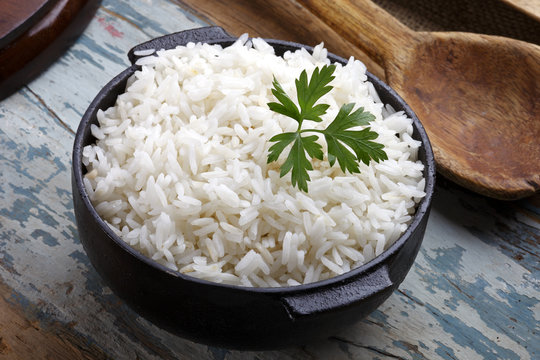
Photo from: Adobe Stock
No discussion of adobo is ever complete without rice, the loyal companion that turns a dish into a meal. Rice is more than just sustenance in the Philippines; it’s security, comfort, and identity in well-cooked grains.
The rice journey from farm to table is perhaps the most complicated of all the adobo ingredients, with multiple steps and multiple middlemen. It starts at Nueva Ecija and Isabela rice fields and Mindanao’s farm lands, where the farm workers sow, care for, and harvest the grain that will nourish a million Filipino households (Department of Agriculture, 2022).
The cycle is simple enough: cultivation, irrigation, harvest, milling, distribution, and retail; but each step has complex systems and interrelationships from individual farmers to government bureaus. Rice goes through different hands before it ends up in your kitchen: farmers, the National Food Authority (NFA), and retailers, each point of transfer costing and complicating.
What is most interesting about the history of rice is that although the Philippines is a rice-producing country with a close cultural affinity with the grain, the country imports large quantities of rice, most of which come from Vietnam. It is a symbol of bigger problems in Philippine agriculture: problems of productivity, infrastructure, and the economics of small-scale versus large-scale production and importation.
The milling process refines coarse rice into the smooth grains we recognize, but it is also a loss of taste and nutrition that many advocates of traditional foods bemoan. Rice on your plate is often far removed from the whole grain traditional Filipino dishes would have enjoyed, a reflection of wider changes in food processing and consumer demand.
The Cooking Moment: When It All Comes Together
After all of those travels, all roads lead to one place: when ingredients and heat come together in your kitchen. But something more is occurring in that cooking time that is so easily overlooked: the work and artistry that goes into every ingredient is being finally appreciated and respected. Every ingredient has contributed not only flavor but stories such as the farmer who raised the pig, the trader who imported the garlic, the processor who processed the soy sauce, and the miller who ground the rice.
The cooking of adobo becomes a gesture of gratitude, a token of thanks to all the hands that permitted the preparation of the meal. When you take your first bite, you’re not just consuming your grandmother’s recipe; you’re consuming the work of dozens of hands whose work enabled that moment to be created.
Why Knowing the Journey Matters
Knowing where our food actually originates does not only appease curiosity by itself, but it transforms the way we engage with what we eat. When you know that your garlic might have traveled thousands of miles or your pork is from a family farm that is combating disease outbreaks, the act of eating becomes more intelligent and participatory.
This consciousness is a duty in the sense that it’s a matter of acknowledging that what we consume is important in ways that reach far beyond our own tastes. When we opt for locally grown garlic instead of foreign produce, we’re aiding farm communities and traditional cultivation. When we hear the seasonal fluctuations of onion prices, we’re tuning into natural cycles and fair trade.
The farm-to-fork tale of adobo reveals the complexity in simplicity, the global connections in local traditions, and the individuals who make each meal. It reminds us that food does not materialize in our own kitchens, but that it comes from afar and with it the sweat and hopes of people whose names we will never know but whose labor we enjoy with every bite.
So next time you sit down to a dish of adobo, pause for a moment and enjoy not only the taste but the history. Support local farmers when you can. Choose Filipino-cultivated garlic when possible. Be conscious of seasonal fluctuations and how these affect agricultural communities. Eat with awareness of the stories your food carries.
References
Andrade, J. I. (2022, August 31). PH heavily reliant on garlic imports to meet demand. INQUIRER.net. https://newsinfo.inquirer.net/1655832/ph-heavily-reliant-on-garlic-imports-to-meet-demand
Antonio, L. L. P. (2023, June 6). Vinegar Manufacturing The Right Way – Philippine Aslam Corporation. Philippine Aslam Corporation. https://philaslam.com/vinegar-manufacturing-the-right-way/
Arcalas, J. E. (2024, June 4). Native garlic to raise local sufficiency to 20 percent. Philstar.com. https://www.philstar.com/business/2024/06/05/2360361/native-garlic-raise-local-sufficiency-20-percent
Department of Agriculture. (2022, June 3). FROM BUSINESS MIRROR: Philippine Rice Production, Varieties and Research: What We Know So Far. Official Portal of the Department of Agriculture. https://www.da.gov.ph/from-business-mirror-philippine-rice-production-varieties-and-research-what-we-know-so-far/
Department of Science and Technology. (2021). “Swine – Industry Strategic Science and Technology Plans (ISPs) Platform.” PCAARRD. https://ispweb.pcaarrd.dost.gov.ph/isp-commodities/swine/
Encyclopedia Britannica. (n.d.). Bay leaf | herb. https://www.britannica.com/topic/bay-leaf
Fernandez-Colorado, C. P., Woo Hyun Kim, Flores, R. A., & Min, W. (2024). African Swine Fever in the Philippines: A Review on Surveillance, Prevention, and Control Strategies. Animals, 14(12), 1816–1816. https://doi.org/10.3390/ani14121816
Fresh Plaza. (2024). “Philippines aims to boost garlic self-sufficiency to 20 percent.” https://www.freshplaza.com/asia/article/9632834/philippines-aims-to-boost-garlic-self-sufficiency-to-20-percent/
Garcia, C. J. J. (2024, May 27). Onion Production Surge: Market Impact, Importation Ban, and Support Initiatives for Farmers in the Philippines – Industry Strategic Science and Technology Plans (ISPs) Platform. Dost.gov.ph. https://ispweb.pcaarrd.dost.gov.ph/onion-production-surge-market-impact-importation-ban-and-support-initiatives-for-farmers-in-the-philippines/
Gaz, C., & Ward, M. (2024). Livestock and Products Annual. In U.S. Department of Agriculture: Foreign Agricultural Service. https://apps.fas.usda.gov/newgainapi/api/Report/DownloadReportByFileName?fileName=Livestock%20and%20Products%20Annual_Manila_Philippines_RP2024-0027.pdf
MasterClass. (2021). How Soy Sauce Is Made: Explore 4 Types of Soy Sauce – 2024 – MasterClass. https://www.masterclass.com/articles/soy-sauce-explained
Micua, L. (2017, August 14). Garlic, “white gold” of Ilocos Region. Philippine News Agency. https://www.pna.gov.ph/articles/1006060
Philippine Statistics Authority. (2022). “Highlights of Garlic Production Ilocos Region, 2022.” https://rsso01.psa.gov.ph/content/highlights-garlic-production-ilocos-region-2022
Sy, J. (2024). Animal Production in the Philippines: Trends, Challenges, and Contributions. ResearchGate. http://dx.doi.org/10.13140/RG.2.2.16627.54564
Veterinaria Digital. (2022). “Philippine Swine Update.” https://www.veterinariadigital.com/en/articulos/philippine-swine-update/

